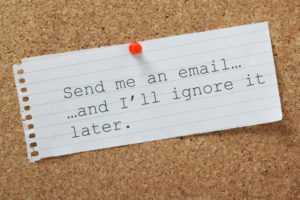Trusted Advisor Customer Service Blog Posts
Written By Jeff Mowatt – (all original content not AI generated)
Written By Jeff Mowatt – (all original content not AI generated)
Ever blame head office?
 Question: at work when an unpopular policy has been announced, have you or whoever introduced it - rather than explaining or justifying the policy - simply blamed head office?
Question: at work when an unpopular policy has been announced, have you or whoever introduced it - rather than explaining or justifying the policy - simply blamed head office?
The message to the local team is, I know this is unwelcome/ unnecessary/ stupid but senior management sitting in their disconnected ivory tower has issued a royal decree, and our job as
serfs is to comply. Even if it makes no sense.
This happens a lot in companies. Branch managers don’t want to take the heat from local employees about an unpopular decision. It’s easier to just blame head office. But consider the damage.
Employees feel like “the company” doesn’t really understand employee challenges out in the field. And if they (senior managers) do understand, they obviously don’t care. Imagine what that does to morale, turnover, and overall teamwork. Corporate silos become more entrenched. A ‘them vs us’ attitude becomes part of the culture. Meanwhile, one of our greatest management challenges is recruiting and retaining staff.
To prevent this fallout from an unpopular decision, consider the comment of a vice president who had brought me in to speak at his annual managers meeting, which included branch managers. “We are all HEAD OFFICE”, he pointedly stated as he gestured to the entire conference room. His message was that anyone in a management/ supervisory role anywhere represents head office. “It’s every manager’s role everywhere to explain why corporate decisions are made.” He continued, “If you don’t understand or agree with a decision, call us first and we’ll take all the time needed to explain it, so you can do the same with your team. But don’t ever just pass a decision off as something insisted upon by head office. Again, we are all head office.”
Speaking of ‘head office’, one of my clients, a senior exec in a multinational manufacturing firm, told me they consciously stopped using that term. They didn’t like that ‘head office’ made it sound more important than the branches. They merely switched the term to ‘home office.’ Simple and smart.
Three “teambuilding” activities that backfire
 Ever attend a “teambuilding event” at work that backfired? Consider these examples:
Ever attend a “teambuilding event” at work that backfired? Consider these examples:
- At the annual December company dinner, an employee who overindulges at the bar makes an inappropriate comment/ pass at another employee. That Monday, the subject of the unwanted attention files a complaint with HR.
- At the summer company bar-b-que, several people (extroverts) who are on vacation can’t attend and feel like they’ve missed-out. Others (introverts) are relieved they have an excuse to avoid it.
- At an offsite paintball outing, a somewhat out of shape employee stumbles over an obstacle, which at first causes some co-workers to laugh, but actually requires knee surgery.
In each case, well-intended managers hope the event will enhance team bonding and boost cooperation. Unfortunately, it has the opposite effect.
Company meals and events should be seen as bonuses or perks (that are sometimes expensive and risky). But they aren’t teambuilding events. Walking a high ropes course or completing a fire-walk has virtually no relevance to the problem of the service department blaming the sales department when a customer is upset.
In my 30 years of clients bringing me in to engage teams, I’ve observed that trying to enhance teamwork is like trying to fall asleep. Teamwork, like sleeping, is a byproduct of other steps you take to make it happen. In other words, teamwork is a side effect of everyone focusing on the larger goal - delighting internal and external customers.
That’s why for my client leadership teams, I walk them through staging monthly Customer Service Team meetings - CAST©. In 90 minute meetings, managers use the CAST tool to enhance internal and external customer service culture. Results: teams become more focused on service and more motivated to deliver it. Teamwork is the happy side effect.
Interested in staging your own CAST meetings? Check out the step-by step-process in my book, Becoming a Service Icon in 90 Minutes a Month I’ll also be staging virtual seminars on the topic this fall. Details are at Leading a Customer-Focused Team
2 keys to Advancing your Career
 Hopefully, at this stage of your career, you’ve discovered that the number one key to advancing your long-term career and your reputation is not friendliness, expertise, or even talent. While all those qualities are admirable, I would argue that your family, customers, and co-workers judge you on more than anything is reliability. In other words, you don’t make excuses, you simply deliver as promised – every time. That’s easy - until things go wrong.
Hopefully, at this stage of your career, you’ve discovered that the number one key to advancing your long-term career and your reputation is not friendliness, expertise, or even talent. While all those qualities are admirable, I would argue that your family, customers, and co-workers judge you on more than anything is reliability. In other words, you don’t make excuses, you simply deliver as promised – every time. That’s easy - until things go wrong.
When everything goes well, chances are your customers and co-workers are not delighted. They are merely getting what they expected so they are satisfied. That doesn’t mean they are loyal or that they’d recommend you. Or promote you or give you a raise. Over the longer term when things go wrong (as eventually they will), or seem hard or inconvenient – that’s when people see if you are actually trust-worthy.
Assuming you are reliable – (even when things go wrong), here’s a second key to boosting your reputation - exceeding expectations. The good news is this is often much easier than it sounds. A couple of examples:
- You think you can complete a customer request within the next 3 hours. You ask the customer when they need it. They reply, “Within 3 days”. Your commitment, “You’ll have it within 24 hours.”
- A customer shipment arrives slightly damaged. Since shipping for this product is so expensive or slow, you’re prepared to give the customer up to 40% off for accepting the defect. Instead of offering that percentage, you apologize, state that you want to be fair and ask, “What do you think would be fair?” The customer says a 10% refund would be acceptable. You reply that in appreciation for their business and by way of apology you’ll double that amount and give them 20% off.
In both scenarios you are exceeding customer expectations, so they are likely delighted, feeling more loyal than before the foul-up, and more inclined to recommend you. And you are giving yourself more time and giving away less than what you were prepared to offer. The key is beginning by asking the customer what their expectations are, and then exceeding them.
How about you and your team members? Is there room for improvement in the way you’re establishing customer expectations and delivering on those promises?
Cranky customers wearing you down?
 If you sense customers are becoming more impatient and demanding, you’re not alone. My clients tell me about how price hikes and supply chain issues are putting more pressure on their customers. The lack of control over timelines and costs is taking a toll on everyone’s patience. So, today’s tip is somewhat unconventional.
If you sense customers are becoming more impatient and demanding, you’re not alone. My clients tell me about how price hikes and supply chain issues are putting more pressure on their customers. The lack of control over timelines and costs is taking a toll on everyone’s patience. So, today’s tip is somewhat unconventional.
We may not have control over customers being stressed, but we do have control over our reactions. This time I’m not talking about phrases that help defuse tense situations (tips I share in my seminars). In this case, I’m talking about feeling less stressed by using one strategy – exercise before going to work.
You’ve likely had days where you have so many demands pulling at you from all sides, you may feel – as one manager client of mine stated – “defeated by your day”. You may even need to stay after hours to finish what you started in the morning. Here’s the rub… chances are in that scenario you not only feel stressed and exhausted, you also feel some guilt over missing a workout.
By exercising before arriving for work – or even sneaking in a mini workout/ walk/ stretch at lunchtime - you help recover from stress. Your entire system is reoxygenated and re-energized. Best of all you feel a sense of self-worth rather than guilt, knowing you’re still taking care of your health. That sense of calm comes through in your communications with others and helps everyone around you gain some perspective. Plus, at the end of the day, you bring a nicer, healthier person home to your family/ roommates/ goldfish.
Being kind to customers starts with being kind to yourself.
Too many interruptions? Consider this.
 Supply chain shortages, backlogs and price hikes have caused increasing numbers of customers to voice questions and concerns that may have you and your team feeling pressured. Employees trying to finish a task for one customer may become flustered when ‘interrupted’ with another request. That’s a formula for a bad day for a lot of people.
Supply chain shortages, backlogs and price hikes have caused increasing numbers of customers to voice questions and concerns that may have you and your team feeling pressured. Employees trying to finish a task for one customer may become flustered when ‘interrupted’ with another request. That’s a formula for a bad day for a lot of people.
That’s why, when managers bring me in for team training, we talk about several guiding principles when juggling multiple customers such as:
Customers are not interruptions
As LL Bean put it, customers are not interruptions to our work, they are the purpose of
our work. Rather than becoming annoyed at all the customer inquiries, we need to remember that without those customers, we wouldn’t be employed. So, broaden your smile and be grateful when more customers come at you. This is a good thing.
Don’t abandon customers midstream
It’s rude to interrupt a customer who’s in front of you to accept phone calls. Instead, use the backup of other team members or voicemail.
Acknowledge visitors right away
When talking with a customer in front of you, briefly acknowledge any new in-person arriving as they enter. Invite them to have a coffee/ seat and explain you’ll be with them soon. Then complete the work with the first customer.
Create systems for managing multiple customers
There’s no excuse for forcing customers to wait unreasonably. Nor should management expect employees to rush through customer interactions. It only creates more problems with morale, mistakes, and customer experience. Management needs to invest in customer service systems; be they artificial intelligence chat bots, FAQs on your website, and adequate staffing and/or outsourcing to handle customer surges.
Don’t be part of the problem
As customers, we’ve all been subjected to staff who seemed more interested in chatting with one another than serving customers. Sometimes the culprit is a manager who interrupts frontline workers in front of customers. Frontline staff need to make themselves visible and available. Generally, coworker conversations should take place behind the scenes.
The good news is most customers understand supply issues and delays. As long as we are seen to be caring about their concerns, and about their valuable time, we can continue to build customer loyalty. That makes everyone’s day go better.
Which of these will lose a sale faster?
 Imagine a potential customer talking about their product preferences and pet peeves. Which of these is most likely to lose the sale:
Imagine a potential customer talking about their product preferences and pet peeves. Which of these is most likely to lose the sale:
- Not having the exact solution the buyer is seeking.
- Having a higher price than the buyer has in mind.
- Glossing over or ignoring the customer’s pet peeve.
If you answered c) ignoring pet peeves, congratulations – you win the sale!
One of the most common mistakes I’ve discovered when managers bring me into coach their sales and service teams is selective hearing. Employees typically pay close attention when they sense they have a possible solution to fulfill the customer’s desires. However, when buyers mention what they don’t want, employees tend to tune-out. Then, when describing a possible solution, employees list all the positives, but pretend they didn’t hear about the negatives.
That strategy rarely works since it indicates we didn’t listen well. It erodes trust.
Next time you’re describing the benefits of your products or services, make a point of bringing up the customer’s concerns. Explain how these benefits either address or outweigh those concerns. Avoid saying ‘but’. Instead use, that’s why… For example, “I know you were concerned about delivery delays. That’s why I’m suggesting this model, which is higher priced. However, it’s in-stock and you’ll have it today, rather than having to wait 3 months.”
Bottom line – don’t ignore customer concerns. Raise them and embrace them.
Frustrated Customers? Try this
 Question - how are supply chain issues, price hikes, and staff shortages impacting your customer relationships? The obvious answer might be, “Customers are not happy with all the bad news, so customer relationships are increasingly under strain.”
Question - how are supply chain issues, price hikes, and staff shortages impacting your customer relationships? The obvious answer might be, “Customers are not happy with all the bad news, so customer relationships are increasingly under strain.”
Maybe. But what if the opposite was possible?
I mean, yes if customers are merely told what they want to hear about timelines, prices, and service, then they’ll be frustrated and angry when their expectations aren’t met. But what if your team members were trained to change the way they grow customer relationships?
What if, rather than assuming strong customer relationships are built around friendliness, instead your team focused primarily on building customer trust. As I share in my seminars, that would mean:
- Instead of reacting to customer concerns, team members would proactively communicate about upcoming issues.
- Instead of agreeing to unreasonable customer demands, team members would be assertive at the outset about realistic delivery expectations.
- Instead of hoping customers will forgive the ‘bad news’, employees explore creative ways with customers to overcome obstacles.
This covid-coaster supply chain perfect storm is a unique opportunity to differentiate your service. By proactively working with customers through difficult periods, you are seen – not as a supplier, service provider, or vendor – but instead as a strategic partner. Adjusting your team’s communications means your customer relationships won’t be strained – they’ll be strengthened.
Using Stories that Sell for you
 "I’m using you and Mom to sell more skis!” This was our daughter, Nicole who, while attending university, has a part-time job at a local ski shop. She said she often talks about me or Lydia as an example when she recommends the Volkl Blaze skis we bought last year.
"I’m using you and Mom to sell more skis!” This was our daughter, Nicole who, while attending university, has a part-time job at a local ski shop. She said she often talks about me or Lydia as an example when she recommends the Volkl Blaze skis we bought last year.
Nicole said if it’s an experienced skier or a customer around our age she’ll point out, “My dad is an ex racer with knee issues… he doesn’t want to fight the skis, and he loves these ones.” Or if it’s a relatively new skier, Nicole will explain, “My mom only started skiing a few years ago and when she switched to these skis, she found it so much easier.” Nicole said practically every time when they hear those examples, they instantly buy! I’m thrilled because the examples are true and Nicole is helping her customers, herself, and the store – everyone wins! (And I admit I’m just a proud dad.) :-D
Slow responses to your emais? Here’s a one minute fix.
 What if there was an instant way to build more trust with your customers every time you sent emails? It costs zero and only takes about one minute one time to set up. The resulting boost in trust is often the difference between your messages being sent to trash, or actually being read and responded to.
What if there was an instant way to build more trust with your customers every time you sent emails? It costs zero and only takes about one minute one time to set up. The resulting boost in trust is often the difference between your messages being sent to trash, or actually being read and responded to.
I’m referring to the practice of simply adding FULL signature details to your emails. And by full, I mean including your first and last name, title, company name, company physical address (demonstrating this is a real entity and not a scam), and single preferred phone number. (Note, providing 2-3 phone numbers for home, work, and cell is just confusing – pick one for them or state which one is to be used after hours). For even greater credibility add a headshot. The full signature concept applies to emails you send both from your desktop computer and from your mobile device.
The result is similar to that of introducing yourself using your first and last names in person. Revealing fully who you are has three instant benefits:
- Demonstrates that you are transparent. You aren’t hiding anything, and you are comfortable being held accountable.
- Indicates that you are important enough to warrant their attention.
- Reminds them that they are interacting with a person - not an organization - subtly encouraging them to be more respectful.
Plus you’re making it easier for them to phone you if they opt to, without having to search for your number. All achieved by including a full signature to your initial emails. For long back and forth email chains you might use an abbreviated version of your signature for your ‘replies’.
Speaking of long emails that discourage people from actually reading it (especially on mobile devices require a lot scrolling), you can omit all the ‘this is confidential info intended for…’ disclaimer legal jargon at the bottom of emails. The intended or accidental recipient hasn’t agreed to it so it holds no legal weight if you don’t have a signed confidentiality agreement. It just takes up unnecessary space on email chains and clutters the conversation.
How about you - is there room for improvement in the way you end your emails?


